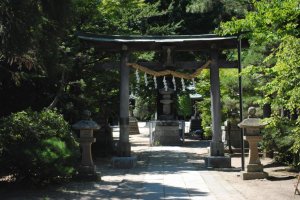I want to present to you two blissful images of Kasukabe Hachiman Shrine, the biggest and best-known in the area. The first is of a crisp, cold-but-calm New Year’s Day. The winding residential streets of Kasukabe seem perfectly tranquil until I reach the shrine approach, whereupon I find crowds of locals backed up for at least 200 meters. It’s like this for much of the first two days of the New Year, and the atmosphere is fantastic – a real event for people of all ages.
For the kids, there are the dozen or so yatai stalls, which you can visit inside the main shrine precinct without queuing up to pray. Few winter delights can put a bigger smile on a kid’s face than a chocolate-coated banana, tako-yaki or fried chicken. For older visitors, there’s the hand-warming heat of the bonfire upon which last year’s lucky charms – now surplus to requirements – are burned in a ceremony known as otaki-age. And to warm up the insides, simply grab a cup of hot, white ama-zake. If you’re lucky, the shrine staff will offer it to you without your having to go hunting.
The second blissful image concerns a beautiful summer’s day in early July, when the inside of the shrine becomes as peaceful as the streets surrounding it. It is the perfect, reasonably-secluded place to escape the hustle and bustle of the city. The shrine approach is decked out in a magnificent array of red, with identical banners on either side conferring health upon your family in authoritative white kanji. At the end of the approach, against a perfectly clear blue sky, the ornate designs of the shrine’s giant canopy gleam and glisten. Mount the steps, insert a coin in the wooden box, and ring the bell gently so that it blends in with the surrounding bird song. Then peacefully pray for whatever you wish.
Take some pictures of the idyllic summer setting and upon finishing photography, what better way to cool down than with the cheapest, coolest alcohol in Kasukabe? I mean, of course, the Yamada wholesaler, the giant yellow – and slightly tattered – façade of which can be seen just opposite Hachiman Park on the main street. There, you can buy your sake, beer or chuu-hai in bulk cheaper than virtually anywhere in the area, plus all your favorite snacks.
In the winter time, take a longer walk to Hachiman from Kasukabe Station to burn off some calories. Simply come out of the West Exit and walk up the main Fujii Street until you reach the crossroads with Shiyakusho Street. Turn right and follow Shiyakusho Street until you reach Hachiman Park, where a left-turn will take you to the shrine entrance. It takes about 25 minutes. In the summer, however, I strongly advise walking up from the Tobu Noda line station of Yagisaki, from which the shrine can be accessed in a mere five minutes. The reason? There is precious little shade in that part of Kasukabe, and if you walk too long, you’ll get sunburn as painful as mine!































